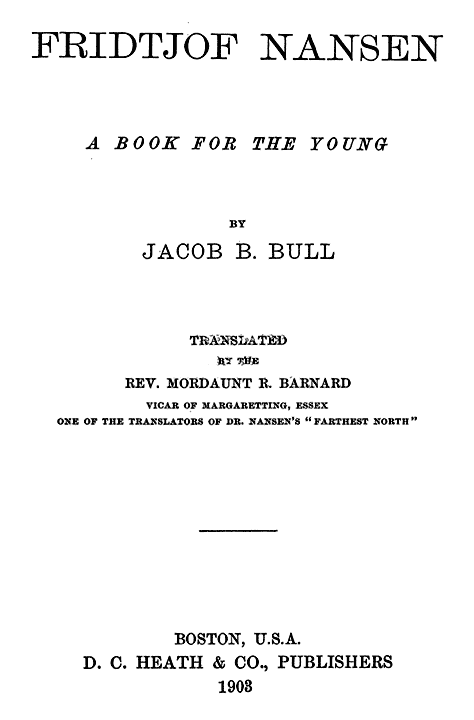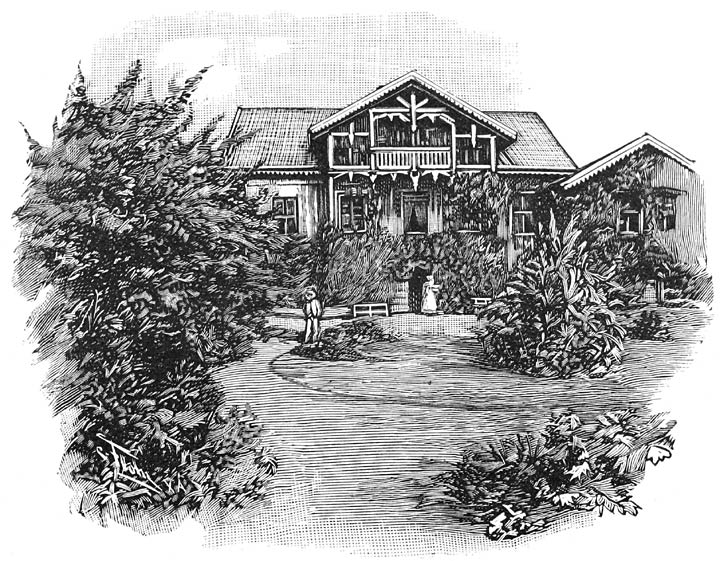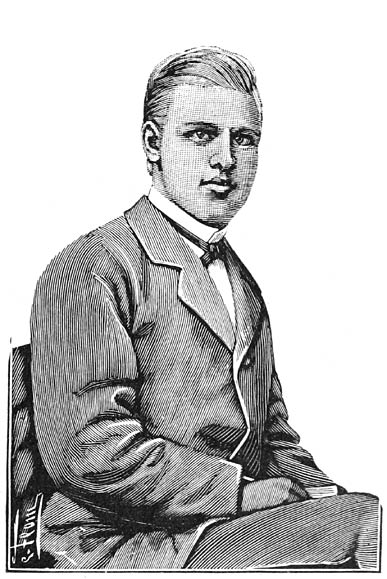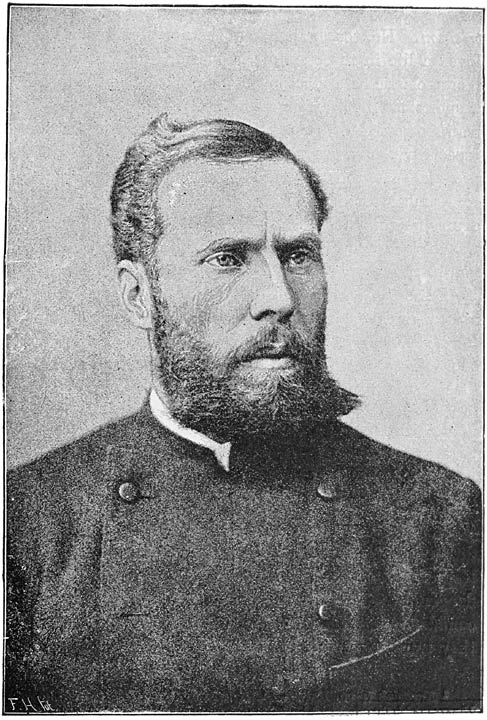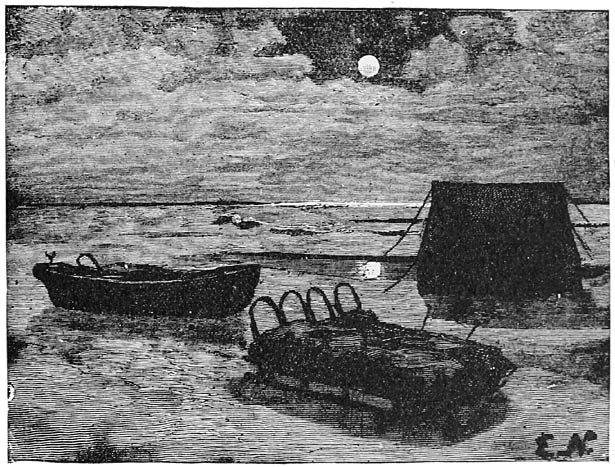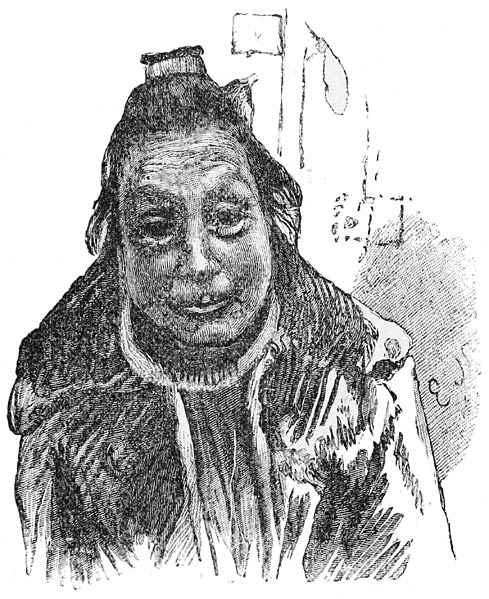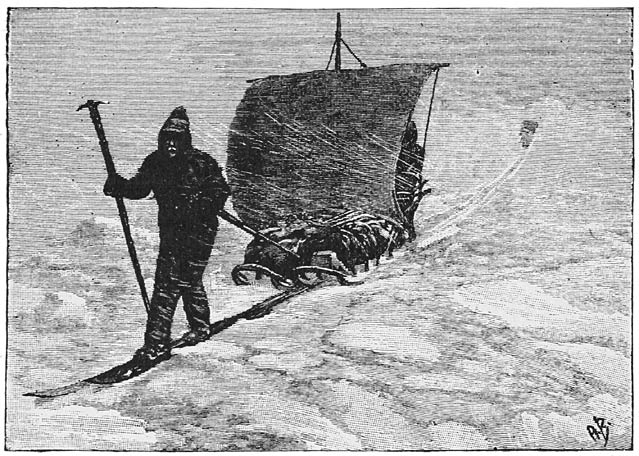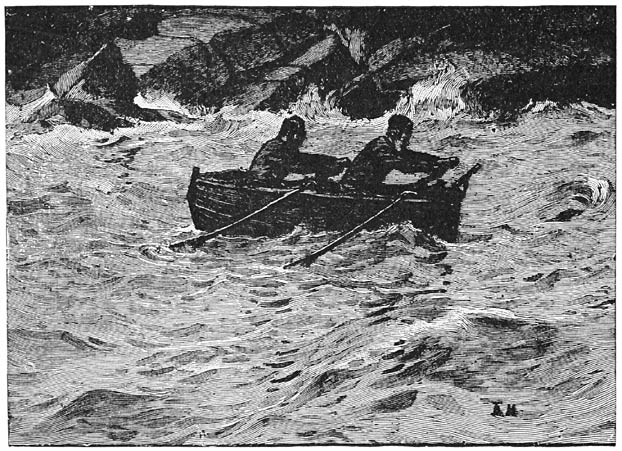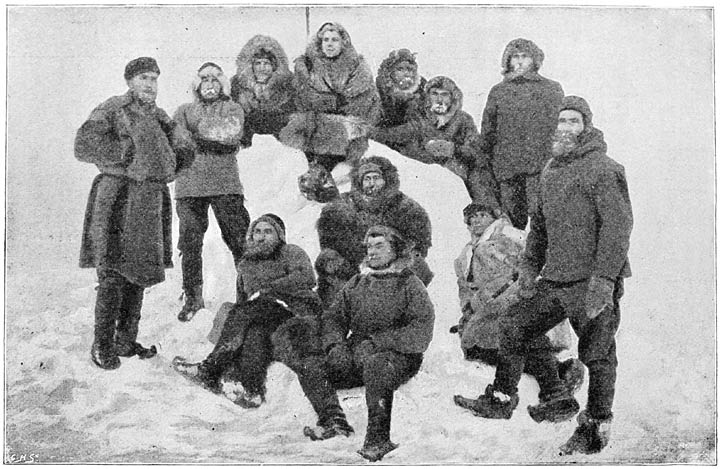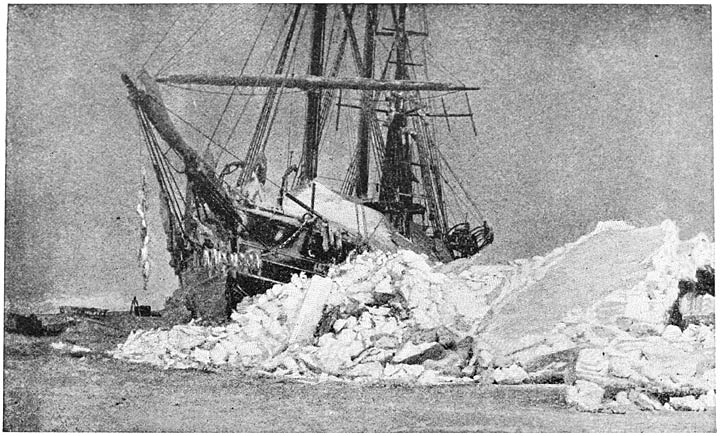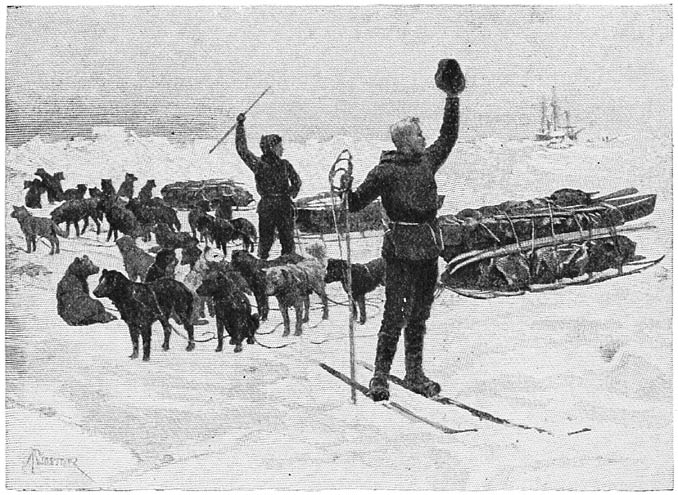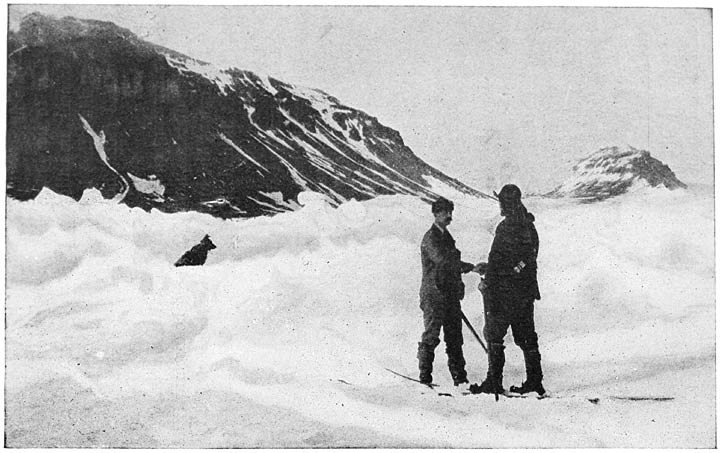When Nansen and his companions, after their perilous
adventures in the drift-ice, landed with flags flying on their boats on
the east waste of Greenland, the first thing they did was to give vent
to their feelings in a ringing hurrah—a sound which those wild
and barren crags had never re-echoed before. Their joy, indeed, on
feeling firm ground beneath their feet once more baffles description.
In a word, they conducted themselves like a pack of schoolboys,
singing, laughing, and playing all manner of pranks. The Lapps,
however, did not partake in the general merriment, but took themselves
off up the mountain-side, where they remained several hours.
But when their first ebullition of joy had somewhat subsided, Nansen
himself followed the example of the Lapps, and clambered up the slope
in order to get a good view over the landscape, leaving the others to
prepare the banquet they determined to indulge in that evening on the
sea-beach. And here he remained some little while, entranced with the
wondrous beauty of the scene. The sea and the ice stretched far away to
the east, shining like a belt of silver beneath him, while on the west
the mountain-tops were bathed in a flood of [52]hazy
sunshine, and the inland ice, the “Sahara of the North,”
extended in a level unbroken plain for miles and miles into the
interior.
A snow bunting perched on a stone close by him, and chirped a
welcome; a mosquito came humming through the air to greet the stranger,
and settled on his hand. He would not disturb it; it was a welcome from
home. It wanted his blood, and he let it take its fill. To the south
the grand outline of Cape Tordenskjold rose up in the horizon, its name
and form recalling his country to his mind; and there arose in his
breast an earnest desire, a deep longing, to sacrifice anything and
everything for his beloved “Old Norway.”
On rejoining his comrades, the feast was ready. It consisted of
oatmeal biscuits, Gruyère cheese, whortleberry jam, and
chocolate; and there is little doubt that these six adventurers
“ate as one eats in the springtime of youth.” For it had
been unanimously resolved that, for this one day at least, they would
enjoy themselves to the full; on the morrow their daily fare would be,
to eat little, sleep little, and work as hard as possible.
To-day, then, should be the first and the last of such indulgence. Time
was precious!
On the next day, therefore, they resumed their northward journey,
along the east coast, fighting their way day and night, inch by inch,
foot by foot, through the drift-ice; at times in peril, at others in
safety; past Cape Adelaer, past Cape Garde, ever forward in one
incessant, monotonous struggle. And now they approached the ill-omened
Puisortok, of which Esquimaux [53]and European seafarers had many an
evil tale to tell. There, it was said, masses of ice would either shoot
up suddenly from beneath the surface of the water, and crush any vessel
that ventured near, or would fall down from the overhanging height, and
overwhelm it. There not a word must be spoken! there must be no
laughing, no eating, no smoking, if one would pass it in safety! Above
all, the fatal name of Puisortok must not pass the lips, else the
glacier would be angry, and certain destruction ensue.
Nansen, however, it may be said, did not observe these regulations,
and yet managed to pass it in safety. In his opinion there was nothing
very remarkable or terrible about it.
But something else took place at Puisortok that surprised him and
his companions.
On July 30, as they were preparing their midday meal, Nansen heard,
amid the shrill cries of the seabirds, a strange weird sound. What it
could be he could not conceive. It resembled the cry of a loon more
than anything else, and kept coming nearer and nearer. Through his
telescope, however, he discerned two dark specks among the ice-floes,
now close together, now a little apart, making straight for them. They
were human beings evidently—human beings in the midst of that
desert region of ice, which they had thought to be a barren,
uninhabited waste. Balto, too, watched their approach attentively, with
a half astonished, half uneasy look, for he believed them to be
supernatural beings.
On came the strangers, one of them bending forward [54]in his
kayak1 as if bowing in salutation; and, on coming
alongside the rock, they crawled out of their kayaks and stood before
Nansen and his companions with bare heads, dressed in jackets and
trousers of seal-skin, smiling, and making all manner of friendly
gestures. They were Esquimaux, and had glass beads in their jet-black
hair. Their skin was of a chestnut hue, and their movements, if not
altogether graceful, were attractive.
On coming up to our travellers they began to ask questions in a
strange language, which, needless to say, was perfectly unintelligible.
Nansen, indeed, tried to talk to them in Esquimau from a conversation
book in that tongue he had with him, but it was perfectly useless. And
it was not till both parties had recourse to the language of signs that
Nansen was able to ascertain that they belonged to an Esquimau
encampment to the north of Puisortok.
These two Esquimaux were good-natured looking little beings; and now
they began to examine the equipments of the travellers, and taste their
food, with which they seemed beyond measure pleased, expressing their
admiration at all they saw by a long-drawn kind of bovine bellow.
Finally they took leave, and set off northward in their kayaks which
they managed with wonderful dexterity, and soon disappeared from
sight.
At six the same evening our travellers followed in the same
direction, and in a short time reached the Esquimau encampment at Cape
Bille. Long, however, [55]before their eyes could detect any signs of
tents or of human beings, their sense of smell became aware of a rank
odor of train-oil, accompanied by a sound of voices; and they presently
saw numbers of Esquimaux standing on the sea-beach, and on the rocks,
earnestly watching the approach of the strangers.
It was a picturesque sight that presented itself to the eyes of our
travellers.
“All about the ledges of the rocks,” writes Nansen,
“stood long rows of strangely wild, shaggy looking creatures,
men, women and children—all dressed in much the same scanty
attire, staring and pointing at us, and uttering the same cowlike sound
we had heard in the forenoon. It was just as if a whole herd of cows
were lowing one against another, as when the cowhouse door is opened in
the morning to admit the expected fodder.”
They were all smiling,—a smile indeed, is the only welcoming
salute of the Esquimaux,—all eager to help Nansen and his
companions ashore, chattering away incessantly in their own tongue,
like a saucepan boiling and bubbling over with words, not one of which,
alas, could Nansen or his companions understand.
Presently Nansen was invited to enter one of their tents, in which
was an odor of such a remarkable nature, such a blending of several
ingredients, that a description thereof is impossible. It was the
smell, as it were, of a mixture of train-oil, human exhalations, and
the effluvium of fetid liquids all intimately mixed up together; while
men and women, lying on the floor round the fire, children rolling
about everywhere, dogs sniffing [56]all around, helped to make up a
scene that was decidedly unique.
All of the occupants were of a brownish-greyish hue, due mostly to
the non-application of soap and water, and were swarming with vermin.
All of them were shiny with train-oil, plump, laughing, chattering
creatures—in a word, presenting a picture of primitive social
life, in all its original blessedness.
Nansen does not consider the Esquimaux, crosseyed [57]and
flat-featured though they be, as by any means repulsive looking. The
nose he describes, in the case of children, “as a depression in
the middle of the face,” the reverse ideal, indeed, of a European
nose.
On the whole he considers their plump, rounded forms to have a
genial appearance about them, and that the seal is the Esquimau
prototype.
The hospitality of these children of nature was boundless. They
would give away all they possessed, even to the shirt on their backs,
had they possessed such an article; and certainly showed extreme
gratitude when their liberality was reciprocated, evidently placing a
high value on empty biscuit-tins, for each time any of them got one
presented to him he would at once bellow forth his joy at the gift.
But what especially seemed to attract their interest was when Nansen
and his companions began to undress, before turning in for the night
into their sleeping-bags; while to watch them creep out of the same the
next morning afforded them no less interest. They entertained, however,
a great dread of the camera, for every time Nansen turned its dark
glass eye upon them, a regular stampede would take place.
Next day Nansen and the Esquimaux parted company, some of the latter
proceeding on their way to the south, others accompanying him on his
journey northward. The leavetaking between the Esquimaux was peculiar,
being celebrated by cramming their nostrils full of snuff from each
other’s snuff-horns. Snuff indeed is the only benefit, or the
reverse, it seems the Esquimaux have derived from European civilization
up [58]to date; and is such a favorite, one might say
necessary, article with them that they will go on a shopping expedition
to the south to procure it, a journey that often takes them four years
to accomplish!
The journey northward was an extremely fatiguing one, for they
encountered such stormy weather that their boats more than once
narrowly escaped being nipped in the ice. As a set-off, however, to
this, the scenery proved to be magnificent,—the floating
mountains of ice resembling enchanted castles, and all nature was on a
stupendous scale. Finally they reached a harbor on Griffenfeldt’s
Island, where they enjoyed the first hot meal they had had on their
coasting expedition, consisting of caraway soup. This meal of soup was
a great comfort to the weary and worn-out travellers. Here a striking
but silent testimony of that severe and pitiless climate presented
itself in the form of a number of skulls and human bones lying blanched
and scattered among the rocks, evidently the remains of Esquimaux who
in times long gone by had perished from starvation.
After an incredible amount of toil, Nansen arrived at a small island
in the entrance of the Inugsuazmuit Fjord, and thence proceeded to
Skjoldungen where the water was more open. Here they encamped, and were
almost eaten up by mosquitoes.
On Aug. 6 they again set out on their way northward, meeting with
another encampment of Esquimaux, who were, however, so terrified at the
approach of the [59]strangers, that they one and all bolted off to the
mountain, and it was not till Nansen presented them with an empty tin
box and some needles that they became reassured, after which they
accompanied the expedition for some little distance, and on parting
gave Nansen a quantity of dried seal’s flesh.
The farther our travellers proceeded on their journey, the more
dissatisfied and uneasy did Balto and Ravna become. Accordingly one day
Nansen took the opportunity of giving Balto a good scolding, who with
tears and sobs gave vent to his complaints, “They had not had
food enough—coffee only three times during the whole journey; and
they had to work harder than any beast the whole livelong day, and he
would gladly give many thousands of kroner to be safe at home once
more.”
There was indeed something in what Balto said. The fare had
unquestionably been somewhat scanty, and the work severe; and it was
evident that these children of nature, hardy though they were, could
not vie with civilized people when it became a question of endurance
for any length of time, and of risking life and taxing one’s
ability to the utmost.
Finally, on Aug. 10, the expedition reached Umivik in a dense fog,
after a very difficult journey through the ice, and encamped for the
last time on the east coast of Greenland. Here they boiled coffee, shot
a kind of snipe, and lived like gentlemen, so that even Balto and Ravna
were quite satisfied. The former, indeed, began intoning some prayers,
as he had heard the priest in Finmarken do, in a very masterly
manner,—a pastime, [60]by the way, he never indulged in
except he felt his life to be quite safe.
The next day, Aug. 11, rose gloriously bright. Far away among the
distant glaciers a rumbling sound as of cannon could be heard, while
snow-covered mountains towered high, overhead, on the other side of
which lay boundless tracts of inland ice. Nansen and Sverdrup now made
a reconnoitring expedition, and did not return till five o’clock
the next morning. It still required some days to overhaul and get
everything in complete order for their journey inland; and it was not
till nine o’clock in the evening of Aug. 16, after first dragging
up on land the boats, in which a few necessary articles of food were
stored, together with a brief account of the progress of the expedition
carefully packed in a tin box, that they commenced their journey across
the inland ice.
Nansen and Sverdrup led the way with the large sleigh, while the
others, each dragging a smaller one, followed in their wake. Thus these
six men, confident of solving the problem before them, with the firm
earth beneath their feet, commenced the ascent of the mountain-slope
which Nansen christened “Nordenskjöld’s
Nunatak.”2
Their work had now begun in real earnest—a work so severe and
arduous that it would require all the strength and powers of endurance
they possessed to accomplish it. The ice was full of fissures, and
these had either to be circumvented or crossed, a very difficult matter
with heavily laden sleighs. A covering of [61]ice often lay over these
fissures, so that great caution was required. Hence their progress was
often very slow, each man being roped to his fellow; so that if one of
them should happen to disappear into one of these fathomless abysses,
his companion could haul him up. Such an occurrence happened more than
once; for Nansen as well as the others would every now and then fall
plump in up to the arms, dangling with his legs over empty space. But
it always turned out well; for powerful hands took hold of the rope,
and the practised gymnasts knew how to extricate themselves.
At first the ascent was very hard work, and it will readily be
understood that the six tired men were not sorry on the first night of
their journey to crawl into their sleeping-bags, after first refreshing
the inner man with cup after cup of hot tea.
Yet, notwithstanding all the fatigue they had undergone, there was
so much strength left in them that Dietrichson volunteered to go back
and fetch a piece of Gruyère cheese they had left behind when
halting for their midday meal. “It would be a nice little morning
walk,” he said, “before turning in!” And he actually
went—all for the sake of a precious bit of cheese!
Next day there was a pouring rain that wet them through. The work of
hauling the sleighs, however, kept them warm. But later in the evening,
it came down in such torrents that Nansen deemed it advisable to pitch
the tent, and here they remained, weather-bound, for three whole days.
And long days they were! But our travellers followed the example of
[62]bruin in winter; that is, they lay under shelter
the greater part of the time, Nansen taking care that they should also
imitate bruin in another respect,—who sleeps sucking his
paw,—by giving them rations once a day only. “He who does
no work shall have little food,” was his motto.
On the forenoon of the twentieth, however, the weather improved; and
our travellers again set out on their journey, having first indulged in
a good warm meal by way of recompense for their three days’
fasting. The ice at first was very difficult, so much so that they had
to retrace their steps, and, sitting on their sleighs, slide down the
mountain slope. But the going improved, as also did the weather.
“If it would only freeze a little,” sighed Nansen. But he
was to get enough of frost before long.
On they tramped, under a broiling sun, over the slushy snow. As
there was no drinking-water to be had, they filled their flasks with
snow, carrying them in their breast-pockets for the heat of their
bodies to melt it.
On Aug. 22 there was a night frost; the snow was hard and in good
condition, but the surface so rough and full of lumps and frozen waves
of slush, that the ropes with which they dragged the sleighs cut and
chafed their shoulders. “It was just as if our shoulders were
being burnt,” Balto said.
They now travelled mostly by night, for it was better going then,
and there was no sun to broil them; while the aurora borealis, bathing
as it were the whole of the frozen plain in a flood of silvery light,
inspired [63]them with fresh courage. The surface of the ice
over which they travelled was as smooth and even as a lake newly frozen
over. Even Balto on such occasions would indulge in a few oaths, a
thing he never allowed himself except when he felt “master of the
situation.” He was a Finn, you see, and perhaps had no other way
of giving expression to his feelings!
As they got into higher altitudes the cold at night became more
intense. Occasionally they were overtaken by a snowstorm, when they had
to encamp in order to avoid being frozen to death; while at times,
again, the going would become so heavy in the fine drifting snow that
they had to drag their sleighs one by one, three or four men at a time
to each sleigh, an operation involving such tremendous exertion that
Kristiansen, a man of few words, on one such occasion said to Nansen,
“What fools people must be to let themselves in for work like
this!”
To give some idea of the intense cold they had to encounter it may
be stated that, at the highest altitude they reached,—9,272 feet
above the sea,—the temperature fell to below -49° Fahrenheit,
and this, too, in the tent at night, the thermometer being under
Nansen’s pillow. And all this toil and labor, be it remembered,
went on from Aug. 16 to the end of September, with sleighs weighing on
an average about two hundred and twenty pounds each, in drifting
snow-dust, worse than even the sandstorms of Sahara.
In order to lighten their labor, Nansen resolved to use sails on the
sleighs—a proceeding which Balto highly disapproved of:
“Such mad people he had [64]never seen before, to want to sail
over the snow! He was a Lapp, he was, and there was nothing they could
teach him on land. It was the greatest nonsense he had ever heard
of!”
Sails, however, were forthcoming, notwithstanding Balto’s
objections; and they sat and stitched them with frozen fingers in the
midst of the snow. But it was astonishing what a help they proved to
be; and so they proceeded on their way, after slightly altering their
course in the direction of Godthaab.3
Thus, then, we see these solitary beings, looking like dark spots
moving on an infinite expanse of snow, [65]wending their way ever
onward, Nansen and Sverdrup side by side, ski-staff and ice-axe in
hand, in front, earnestly gazing ahead as they dragged the heavy
sleigh, while close behind followed Dietrichson and Kristiansen, Balto
and Ravna bringing up the rear, each dragging a smaller sleigh. So it
went on for weeks; and though it tried their strength, and put their
powers of endurance to a most severe test, yet, if ever the thought of
“giving it up” arose in their minds, it was at once scouted
by all the party, the two Lapps excepted. One day Balto complained
loudly to Nansen. “When you asked us,” he said, “in
Christiania, what weight we could drag, we told you we could manage one
hundredweight each, but now we have double that weight, and all I can
say is, that, if we can drag these loads over to the west coast, we are
stronger than horses.”
Onward, however, they went, in spite of the cold, which at times was
so intense that their beards froze fast to their jerseys, facing
blinding snowstorms that well-nigh made old Ravna desperate. The only
bright moments they enjoyed were when sleeping or at their meals. The
sleeping-bags, indeed, were a paradise; their meals, ideals of perfect
bliss.
Unfortunately, Nansen had not taken a sufficient supply of fatty
food with him, and to such an extent did the craving for fat go, that
Sverdrup one day seriously suggested that they should eat
boot-grease—a compound of boiled grease and old linseed oil!
Their great luxury was to eat raw butter, and smoke a pipe after it.
First they would smoke the fragrant weed [66]pure and simple; when
that was done, the tobacco ash, followed by the oil as long as it would
burn; and when this was all exhausted, they would smoke tarred yarn, or
anything else that was a bit tasty! Nansen, who neither smoked nor
chewed, would content himself with a chip of wood, or a sliver off one
of the “truger” (snowshoes). “It tasted good,”
he said, “and kept his mouth moist.”
Finally, on Sept. 14, they had reached their highest altitude, and
now began to descend toward the coast, keeping a sharp lookout for
“land ahead.” But none was yet to be seen, and one day
Ravna’s patience completely gave way. With sobs and moans he said
to Nansen,—
“I’m an old Fjeld-Lapp, and a silly old fool! I’m
sure we shall never get to the coast!”
“Yes,” was the curt answer, “it’s quite
true! Ravna is a silly old fool!”
One day, however, shortly afterward, while they were at dinner, they
heard the twittering of a bird close by. It was a snow-bunting,
bringing them a greeting from the west coast, and their hearts grew
warm within them at the welcome sound.
On the next day, with sails set, they proceeded onward down the
sloping ground, but with only partial success. Nansen was standing
behind the large sleigh to steady it, while Sverdrup steered from the
front. Merrily flew the bark; but, unfortunately, Nansen stumbled and
fell, and had hard work to regain his legs, and harder work still to
gather up sundry articles that had fallen off the sleigh, such as boxes
of pemmican, [67]fur jackets, and ice-axes. Meanwhile Sverdrup and
the ship had almost disappeared from view, and all that Nansen could
see of it was a dark, square speck, far ahead across the ice. Sverdrup
had been sitting all the while in front, thinking what an admirable
passage they were making, and was not a little astonished, on looking
behind, to find that he was the only passenger on board. Matters,
however, went on better after this; and in the afternoon, as they were
sailing their best and fastest, the joyful cry of “Land
ahead!” rang through the air. The west coast was in sight! After
several days’ hard work across fissures and over uneven ice, the
coast itself was finally reached. But Godthaab was a long, long way off
still, and to reach it by land was sheer impossibility.
The joy of our travellers on once more feeling firm ground beneath
their feet, and of getting real water to drink, was indescribable. They
swallowed quart after quart, till they could drink no more. The Lapps,
as usual took themselves off to the fjeld to testify their joy.
That evening was the most delightful one they had experienced for
weeks, one never to be forgotten in after years, when, with their tent
pitched, and a blazing fire of wood, they sat beside it, Sverdrup
smoking a pipe of moss in lieu of tobacco, and Nansen lying on his back
on the grass, which shed a strange and delightful perfume all
around.
But how was Godthaab to be reached? By land it was impossible!
Therefore the journey must be made by sea! But there was no boat! A
boat, then, must be built. And Sverdrup and Nansen were the men to
[68]solve the problem. They set to work, and by
evening the boat was finished. Its dimensions were eight feet five
inches in length, four feet eight inches in breadth, and it was made of
willows and sail-cloth. The oars were of bamboo and willow branches,
across the blades of which canvas was stretched. The thwarts were made
from bamboo, and the foot of one of their scientific instruments which,
by the way, chafed them terribly, and were very uncomfortable
seats.
All preparations being now made, Nansen and Sverdrup set off on
their adventurous journey. The first day it was terribly hard work, for
the water was too shallow to admit of rowing. On the second day,
however, they put out to sea. Here they had at times to encounter
[69]severe weather, fearing every moment lest their
frail bark should be swamped or capsized. At night they would sleep on
the naked shore beneath the open sky. From morning till night
struggling away with their oars, living on hot soup and the sea-birds
they shot, which were ravenously devoured without much labor being
devoted to cooking the same. Finally they reached their destination,
meeting with a hearty welcome, accompanied by a salute from cannon
fired off in their honor, when once it was ascertained who the new
arrivals were.
Nansen’s first inquiry was about a ship for Denmark, and he
learned, to his great disappointment, that the last vessel for the
season had sailed from Godthaab two months before, and that the nearest
ship, the Fox, was lying at Ivitgut, three hundred miles off.
It was a terrible blow in the midst of their joy. Home had, as it
were, at one stroke receded many hundreds of miles away; and here they
would have to pass a whole winter and spring, while dear ones at home
would think they had perished, and would be mourning for their supposed
loss all those weary months.
But this must never be! The Fox must be got at, and friends at home
must at all events get letters by her.
After a great deal of trouble Nansen at length found an Esquimau who
agreed to set off in his kayak bearing two letters. One was from Nansen
to Gamel, who had equipped the expedition; the other from Sverdrup to
his father.
This having been arranged, and boats having been [70]sent off
to fetch their comrades from Ameralikfjord, Nansen and Sverdrup plunged
into all the joys and delights of civilized life to which they had so
long been strangers. Now they were able to indulge in the luxury of
soap and water for the first time since the commencement of their
journey across the ice. To change their clothes, to sleep in proper
beds, to eat civilized food with knives and forks on earthenware
plates, to smoke, to converse with educated beings, was to them the
summum bonum of enjoyment, and they felt themselves to be in
clover.
Notwithstanding all these, Nansen did not seem altogether himself.
He was in a dreamy state, thinking perhaps of nights spent in
sleeping-bags up on the inland ice, or dreaming of that memorable
evening in the Ameralikfjord, of the hard struggles they had undergone
on the boundless plains of snow. These things flashed across him,
excluding from his mind the conviction that he had rendered his name
famous.
At last, on Oct. 12, the other members of the expedition joined
them, and these six men, who had risked their lives in that perilous
adventure, were once more assembled together.
His object had been attained, and the name of Fridtjof Nansen would
soon be known the whole world over!
That same autumn the Fox brought to Norway tidings of the success of
the expedition, and a few hours after her arrival the telegraph
announced throughout the length and breadth of the civilized world, in
few but significant words, “Fridtjof Nansen has crossed over the
inland ice of Greenland.” [71]
And the Norwegian nation, which had refused to grant the venturesome
young man 5,000 kroner ($1,350), now raised her head, and called
Fridtjof Nansen one of her best sons. And when one day in April, after
having spent a long winter in Greenland, he went on board the
Hvidbjörn4 on his homeward journey, preparations were
being made in the capital for a festival such as a king receives when
he visits his subjects.
It was May 30: the spring sun was shining with all its brilliancy
over Norway. The Christiania fjord was teeming with yachts and small
sailing-boats. A light breeze played over the ruffled surface of the
water, while the perfume of the budding trees on its banks shed a sweet
fragrance all around. As for the town, it literally swarmed with human
beings. The quays, the fortress, the very roofs of the houses, were
densely packed with eager crowds, all of them intently gazing seaward.
Presently a shout of welcome heard faintly in the distance announced
his approach, gradually increasing in volume as he came nearer, till it
merged into one continuous roar, while thousands of flags were waving
overhead.
Eagerly the crowds pressed forward to catch the first glimpse of his
form, and when they did recognize him, their hurrahs burst forth like a
storm, and were caught up in the streets, answered from the windows,
from the tops of houses; and when they ceased for a moment from the
sheer exhaustion of those who uttered them, they were soon renewed with
redoubled vigor. And when finally Nansen had disembarked and had
entered [72]a carriage, the police could no longer keep the
people under control. As if with one accord they dashed forward, and
taking out the horses, harnessed themselves in their place, and dragged
him through the streets of the city in triumph.
Yes, the Norwegian people had taken possession of Fridtjof
Nansen!
But up at a window there stood the old housekeeper from Store
Fröen, waving her white apron, while tears of joy trickled down
her face. She it was who had bound up his bleeding head when years ago
he had fallen and cut it on the ice; she it was to whom he had often
gone when in some childish scrape. He remembered her in his hour of
triumph. And as she was laughing and crying by turns, and waving her
apron, he dashed up the steps and gave her a loving embrace.
For was she not part and parcel of his home? [73]

